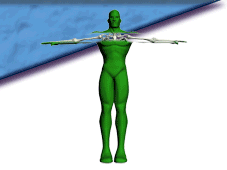Achilles Tendon Injury and Prolotherapy
The following is taken from a lecture done by Dr. Young to students at The Chicago National College of Naprapathy:The first thing to do with this area of pain is to rule out partial or complete rupture. This problem is commonly found in the middle-aged, weekend, male athlete. The pain may be sudden and feel as though it has been hit by an object, or the pain may come on gradually and be a warning sign of impending rupture at a future date without preventive measures.
One traditional orthopedic test to rule out Achilles tendon full or partial rupture is O'Brien's Test. This test is best done by a physician with acupuncture experience because it requires placing an acupuncture needle into the tendon about 10 cm. above the heel attachment of the Achilles. If the needle is seen to swivel as the patient flexes and extends the ankle the Achilles tendon is intact. If the needle does not move a rupture is confirmed. At this point MRI should be performed. Another test requires the patient to lie prone while the examiner bends his knee 90 degrees and squeezes the medial gastrocnemius (calf) muscle. If the foot does not flex with this movement the Achilles is seriously compromised.
Achilles tendonitis therapies include exercises and a special device worn at night called The Strassburg Sock, which has a strong elastic band that stretches from the toe area of the sock to the shin just below the knee at the top of the sock. This holds the Achilles in a stretched position all night thus allowing for tissue remodeling along the lines of stress. It is considered a strong supporter of the action of Prolotherapy in promoting Achilles tendon regrowth. The number one exercise for the acute stage of Achilles tendonitis is called the Calf Roller and the number one exercise for the more chronic stage is called Stairstep Ankle Flexion and Extension.
Many studies have revealed that a ruptured Achilles tendon has pre-existing tissue degenerative changes. The rupture occurs at the location of maximal degeneration, that is, where the tendon is receiving the poorest blood supply. This is most frequently at the critical zone at about 10 cm. above the calcaneal (heel bone) attachment. This zone is usually the prime target area for Prolotherapy or P.I.N.S. Prolotherapy because of its' ability to draw blood (and new tissue growth factors). Thus, this therapy is excellent for both the partially ruptured tendon and the degenerative tendon that has not yet experienced rupture. The skilled Prolotherapist can also take advantage of the use of Acupuncture Corporeal (Body) Tacks located on either side of the tendonitis for ongoing Prolo supporting effects.
Return to the Articles Page
Return to the Where's Your Pain? Page



